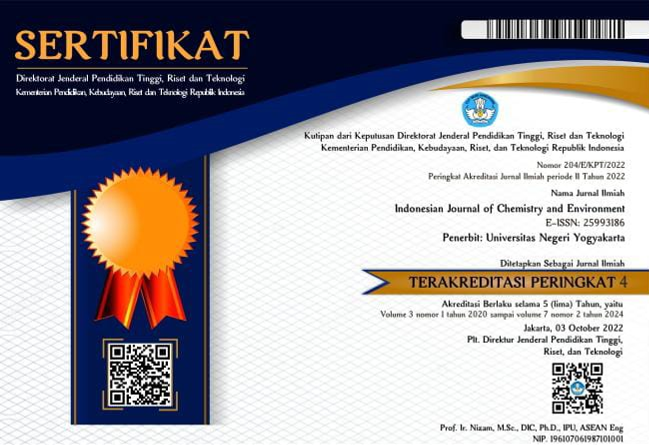Curcumin Electropolymerization to Graphite Modification for Pb2+ Electrochemical Sensing
DOI:
https://doi.org/10.21831/ijoce.v7i2.81727Abstract
Curcumin is an organic ligand that can be electrocatalytic. Curcumin can be coated on graphite electrodes to produce electrodes modified with curcumin (GPC). Curcumin acts as a ligand and forms complex compounds with metals. The modification process was carried out by electropolymerization. The electrochemical method characterized the electroactive area, electron transfer, and interaction between the electrode and Pb2+ metal ions. Functional groups and surface morphology were characterized using FTIR and SEM. Validation of analytical methods including linear range, sensitivity, limit of detection, limit of quantitation, precision, and accuracy. The interaction of the GPC electrode with Pb2+ follows the electrochemical adsorption process. The GPC electrode can identify the presence of Pb2+ metal ions with a range of 3.01-70.03 µM and 181-919.2 µM. The results of the analytical method validation include linear ranges of 3.125-67.400 µM and 179.334-919.5 µM; sensitivity of 3.3605 µA/µM; limit of detection of 6.07 µM; limit of quantitation of 18.39 µM; precision of 0.93%; and accuracy of 99%.Downloads
Published
2024-12-30
How to Cite
[1]
Marwati, S. et al. 2024. Curcumin Electropolymerization to Graphite Modification for Pb2+ Electrochemical Sensing. Indonesian Journal of Chemistry and Environment. 7, 2 (Dec. 2024), 84–92. DOI:https://doi.org/10.21831/ijoce.v7i2.81727.
Issue
Section
Articles
License
Authors who publish with this journal agree to the following terms:
- Authors retain copyright and grant the journal right of first publication with the work simultaneously licensed under a Creative Commons Attribution-NonCommercial-NoDerivatives 4.0 International License that allows others to share the work with an acknowledgement of the work's authorship and initial publication in this journal.
- Authors are able to enter into separate, additional contractual arrangements for the non-exclusive distribution of the journal's published version of the work (e.g., post it to an institutional repository or publish it in a book), with an acknowledgement of its initial publication in this journal.
- Authors are permitted and encouraged to post their work online (e.g., in institutional repositories or on their website) prior to and during the submission process, as it can lead to productive exchanges, as well as earlier and greater citation of published work.









